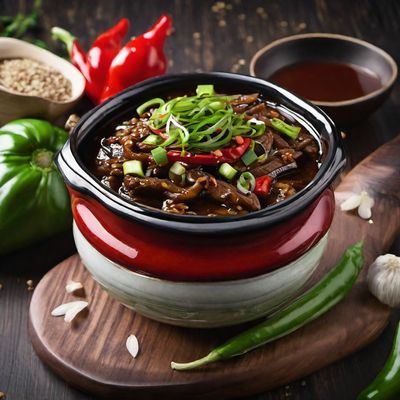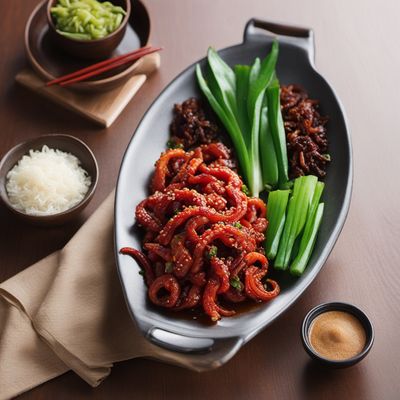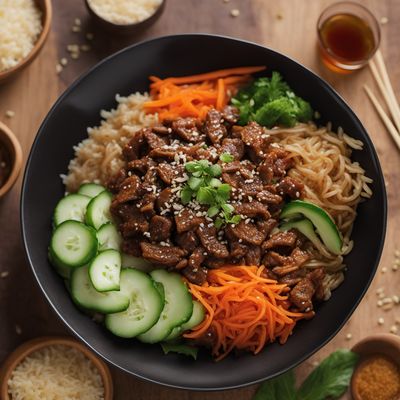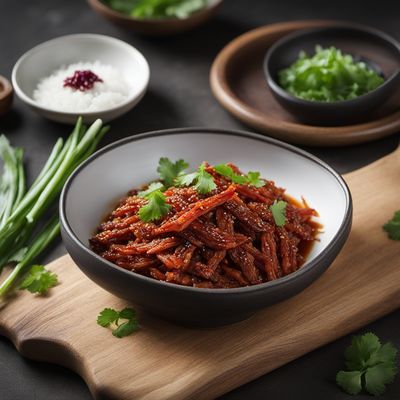
Recipe
Doenjang Jjigae with Tofu and Vegetables
Hearty Korean Soybean Stew with Tofu and Fresh Vegetables
4.7 out of 5
Indulge in the rich flavors of Korean cuisine with this authentic Doenjang Jjigae recipe. This traditional soybean stew is packed with wholesome ingredients like tofu and fresh vegetables, creating a comforting and nourishing dish.
Metadata
Preparation time
15 minutes
Cooking time
25 minutes
Total time
40 minutes
Yields
4 servings
Preparation difficulty
Easy
Suitable for
Vegan, Vegetarian, Gluten-free, Dairy-free, Nut-free
Allergens
Soy, Wheat (if using regular soy sauce instead of gluten-free)
Not suitable for
Paleo, Keto, Low-carb, High-protein, Atkins
Ingredients
-
2 tablespoons (30ml) sesame oil 2 tablespoons (30ml) sesame oil
-
1 onion, thinly sliced 1 onion, thinly sliced
-
3 cloves of garlic, minced 3 cloves of garlic, minced
-
1 tablespoon (15g) gochujang (Korean red pepper paste) 1 tablespoon (15g) gochujang (Korean red pepper paste)
-
2 tablespoons (30g) doenjang (fermented soybean paste) 2 tablespoons (30g) doenjang (fermented soybean paste)
-
4 cups (950ml) vegetable broth 4 cups (950ml) vegetable broth
-
1 zucchini, sliced 1 zucchini, sliced
-
1 carrot, sliced 1 carrot, sliced
-
1 cup (150g) shiitake mushrooms, sliced 1 cup (150g) shiitake mushrooms, sliced
-
1 cup (150g) firm tofu, cubed 1 cup (150g) firm tofu, cubed
-
2 green onions, chopped 2 green onions, chopped
-
1 tablespoon (15ml) soy sauce 1 tablespoon (15ml) soy sauce
-
1 teaspoon (5g) sugar 1 teaspoon (5g) sugar
-
Salt and pepper to taste Salt and pepper to taste
Nutrition
- Calories (kcal / KJ): 220 kcal / 920 KJ
- Fat (total, saturated): 12g, 2g
- Carbohydrates (total, sugars): 20g, 8g
- Protein: 10g
- Fiber: 5g
- Salt: 2g
Preparation
-
1.Heat sesame oil in a large pot over medium heat.
-
2.Add sliced onion and minced garlic, sauté until fragrant and onions are translucent.
-
3.Stir in gochujang and doenjang, cook for 1-2 minutes to release their flavors.
-
4.Pour in vegetable broth and bring to a boil.
-
5.Add zucchini, carrot, shiitake mushrooms, and tofu. Simmer for 10-15 minutes until vegetables are tender.
-
6.Stir in green onions, soy sauce, sugar, salt, and pepper. Cook for an additional 2-3 minutes.
-
7.Adjust seasoning if needed.
-
8.Serve hot with steamed rice.
Treat your ingredients with care...
- Tofu — For a firmer texture, press the tofu before cubing it. Simply place the tofu between paper towels and place a heavy object on top for 15-20 minutes to remove excess moisture.
- Gochujang — Adjust the amount of gochujang according to your spice preference. Add more for a spicier stew or reduce it for a milder flavor.
Tips & Tricks
- For a heartier version, you can add other protein sources like thinly sliced beef or pork.
- Feel free to customize the vegetable selection based on your preferences or seasonal availability.
- Serve the Doenjang Jjigae with a side of kimchi and steamed rice for a complete Korean meal experience.
- Leftovers can be stored in the refrigerator for up to 3 days and reheated for future meals.
- Adjust the saltiness by adding more or less soy sauce, keeping in mind that doenjang already contains salt.
Serving advice
Serve the Doenjang Jjigae hot in individual bowls, accompanied by a bowl of steamed rice. Garnish with additional chopped green onions for a pop of freshness.
Presentation advice
Present the Doenjang Jjigae in a traditional Korean earthenware pot (ttukbaegi) to enhance the authenticity and keep the stew warm throughout the meal. Sprinkle some sesame seeds on top for an added visual appeal.
More recipes...
For Doenjang jjigae
More Korean cuisine dishes » Browse all
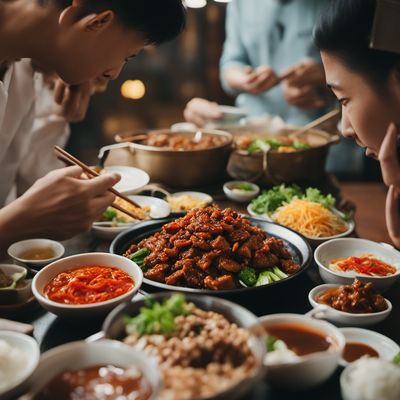
Jeyuk bokkeum
Stir Fried Spicy Pork
Jeyuk bokkeum is a traditional Korean dish that is made with pork and vegetables. The dish is popular all over Korea and is often served as a main course.

Bulgogi
Bulgogi is a Korean dish that is made with marinated beef that is grilled or stir-fried. It is a popular dish in Korea and is enjoyed by many...

Pajeon
Pajeon is a Korean pancake that is made with scallions and seafood. It is a popular dish in Korea and is often served as an appetizer or snack.


